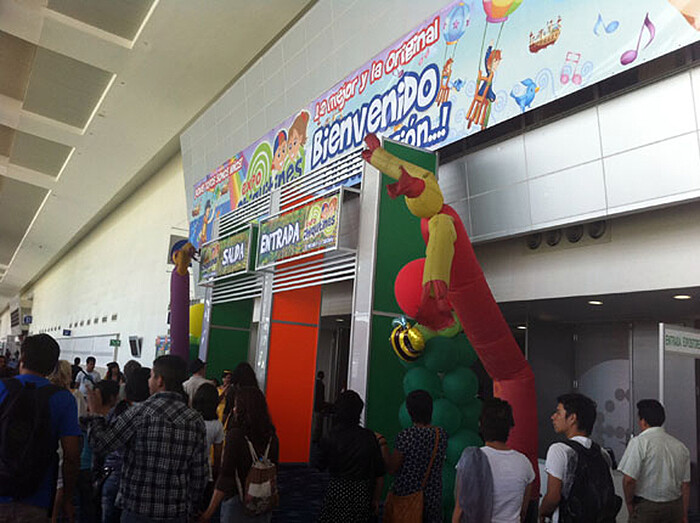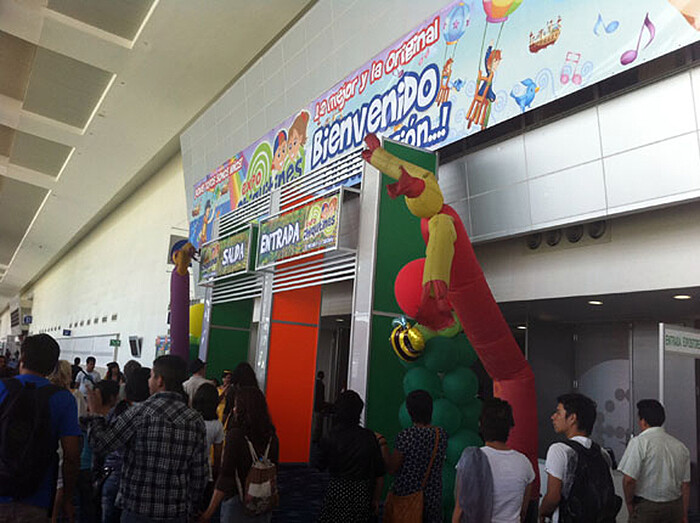While considering the strange juxtaposition of the skyscraper’s program, architect Rem Koolhaas—in his 1978 Delirious New York—speculated that the ‘plot’ of the Downtown Athletic Club’s ninth story was a tale of “eating oysters with boxing gloves, naked.” Similarly congested is the exposition hall, which these days can be found hosting art shows, boating events, music fairs, and so on. Yet Zona Maco and its host, Centro Banamex, layered not only a hippodrome with an art fair, but added a children’s expo, a high-end car parts show, and a security systems fair extravaganza. As such, last week’s festivities presented the opportunity to take your kid to sample unreleased Nintendo games, while perhaps also lavishing a trifecta payout windfall on add-ons for a super and/or muscle car, a new painting or designer desk, while at the same time picking up a new alarm system to guard the loot. Adding a comical flair to this surrealist cut-up, many “test” sirens could be heard sounding off and blending into the aptly named “zone” of the art far. Although Koolhaas lauded the social potentiality that these chance cross-programs offered, Hal Foster—in his essay Bigness from the London Review of Books*—famously questioned this legacy of celebrating excess by suggesting that such rhetoric can slide into “glib” market exuberance. All fairs offer some kind of glorious mélange as each gallery brings what it brings, yet these days many offer a “curated” section, such as Frieze Projects, Art Basel Unlimited, and so on—which, presumably, presents some form of reflective counterpoint, replete with its own internal mash-ups. This year Zona Maco yet again handed the reins of their curated section to independent Brazilian curator, and the forth-coming 12th Istanbul Biennial co-curator Adriano Pedrosa, who has filled these shoes for the last 3 years.
For his section Zona Maco Sur, Pedrosa presented an all female roster of predominantly Latin artists. According to the website, only artists from the Southern Hemisphere were featured, yet I spotted a European or two. At the fair itself, it was hard to understand the conceptual decision behind the selection of artists, as little explanatory material was presented on site. As such, the only position inferred by a visitor without privileged insider information was one of a meta-narrative that presented a hand-picked set of female artists—of which few overtly tackled or referenced gender in their work. And although these curatorial maneuvers coalesced into a compete parade of solo-presentation booths, one after the next, a giant elephant began to lurk in the room. Here, a stereotyped Latin machismo voice seemed to be begging the question: is this focus on woman artists a feminist one?
In order to unpack this further, all one had to do was look about the fair where various other “selections” of women were on “display.” The fair itself hired spokes models in uniformed cocktail dresses to welcome visitors—yet no handsome men were recruited. Likewise, various sponsors, Perrier, AXA, among others, presented a bevy of tall, statuesque hostesses lacking male counterparts. The more pedestrian jobs on the fair’s floor appeared to go to shorter women in less glamorous uniforms. As one might expect, this sex appeal card was played much harder in the adjacent car show, but amazingly it was even present at the children’s fair, with greeters in brightly colored mini-skirts handing promos to prepubescent’s and their parents. As an outsider, I cannot comment on this dance without having undue bias, and yet the flair of it all seemed a bit, well…
In any case, the fair did seem to bring out a huge cross section of people, but almost by script, each and every female guest was outfitted in tremendous heels—which was often the chatter of many I spoke with, man and woman a like. Yet to get back to an earlier question, context must be taken into account when asking if the selection of women as women-artists, as opposed to simply artists, is progressive or not. To say the least, it does offer some empowerment, but then again, it would be wrong to say that the models are simply being taken advantage of. And yet, a larger question looms; are these artists being celebrated for their craft or are they being presented as a category? A riddled paradox indeed, but at least we can say that like the cars, the horses, the toys, they and every artist in the show are being presented primarily as a market—or the opening of new ones—before they are being considered as anything else. This very real “position” which objectifies all is probably why no thesis offering some intellectual basis for the curated section was produced, even just to say by way of disclosure, “Hello, I am a professional curator, and these are some artists whose work has caught my eye lately and I’d just like to share them with you.” This hypothetical is something I can sympathize with, as I have worked with some of these artists, namely Julieta Aranda and Carla Zaccagnini.
Aranda’s piece The Tale of the Tiger is Longer than the Tiger’s Tail (2011)—presented alongside a video just down the hall by Minerva Cuevas depicting local reportage-like footage of social unrest, and Teresa Margolles’s bullet riddled door taken from a crime scene in Mexico’s drug cartel capital, Culiacán—dealt not with gender politics, but with social justice in general. Here, Aranda repurposed the old logo for Grupo Televisa, the largest media conglomerate in the Spanish-speaking world as an architectural plan instead of a simple 2D emblem. With this schematic in hand, the artist constructed a set of 3D elements in varying materials, neon, concrete, and brick, and arranged each around the booth to create a kind of fractured, decomposed installation. Tying this display together was Aranda’s bronze plaque featuring a scathing quotation about the poor by Televisa founder and Mexican Billionaire, Emilio Azcárraga, AKA “el tigre”—a sobriquet he acquired for his ferociously aggressive business dealings.
Approaching Zaccagnini’s booth, one was confronted by a set of framed frottage rubbings depicting glorious sunbursts of clouds and art deco stylized images. These rubbings, however child-like and joyous they looked at first glance, were actually lifted from the face of a cenotaph in Treptower dedicated to the fallen soviet soldiers at the Battle of Berlin in 1945—the clouds and rays are actually explosions. Memorials such as these are often casually passed by, especially when they are vestiges of unwelcomed lost regimes. And yet, these very soldiers sacrificed all to rid the world of a great tyrant, while supporting a revolutionary fervor. This complex mix of emotions—support for a people and not necessarily their cause—holds prescience today as the resistance movements in the Arab World, to name just one example, are sparking both celebratory and concerned commentaries in recent press. In order to dwell on these themes, the very act of touching and tracing the monument, instead of passing by in disregard, elongates an experience of the memorial’s iconography. By shearing these artifacts from this investigation, Zaccagnini has created a second and greater distributed stance against forgetting so easily.
Ideas of memory and unity, or lack there of, continued to play out throughout the fair’s offerings. Danish artist Nina Beier produced an elegiac ballet wherein invited retired professional dancers were asked to perform their entire past repertoire from memory on a minimal stage backed by a framed assemblage of discarded clothing. Yeats’ provocation, “how can we know the dancer from the dance?” flashed into mind as the intensity of the dancers’ faces, which begin with eyes pointed up and to the right in remembrance of images past, morphed into to steely and mesmerizing performance glares. Marcela Armas utilized a vehicular oil pump to push motor oil along a very long tube tacked to the wall, producing an image of a Manhattan-esque skyline. The oil pulsed through an animated city space, to eventually hit the end where it drained, unctuously, under an unattached frame of an oil tanker, to stain the wall and pollute the ground. Equally direct yet more didactic, a neighboring installation featured work by Margarita Paksa, a first hand witness of the tumult of Peronism and later, the traumas of Argentina’s military juntas. Distilling these upheavals into a bold graphic language that borrowed from the vocabulary of Rodchenko, the artist formed a series of prints in which words such as “justice” are reconfigured through the lens of a sniper’s scope.
All in all, the predominate chord in the work presented in Zona Maco Sur did not focus on anything “feminist” at all, but instead appealed to larger themes—the freedom from violence, oppression, prejudice and the like, for all. Key amongst these were Barbarita Cardozo’s framed boards of brand name tags, Nike, Gap, etc., that the artist tore from items still on the rack in stores. Whether this is meant as a critique of purchased and readymade “personal” style, or the business practices of megacorporations, the work hinted at a need to go beyond labels, in general, so as to find textured meanings in our world-at-large. As such, it provided the perfect foil for an easy casting of Zona Maco Sur as a “woman’s” show. In the end, I cannot say if this ultimate synthesis was intentional on Pedrosa’s part, so lets give him the benefit of the doubt and call it, not a disaster, but a happy accident—and let’s just hope that the “witnesses” visiting the fair took note.
*From Bigness (London Review of Books, Vol 23. No. 23, 29 November 2001, pages 13-16) on Rem Koolhaas’s (et al), Harvard Design School Guide to Shopping (2001), and Great Leap Forward (2001). http://www.lrb.co.uk/v23/n23/hal-foster/bigness

















